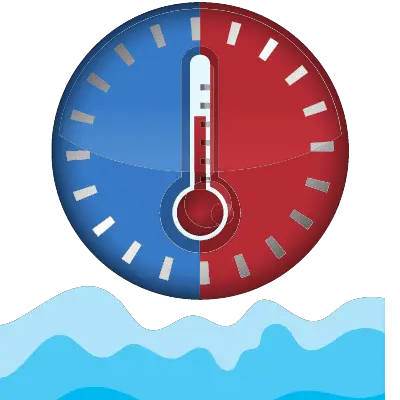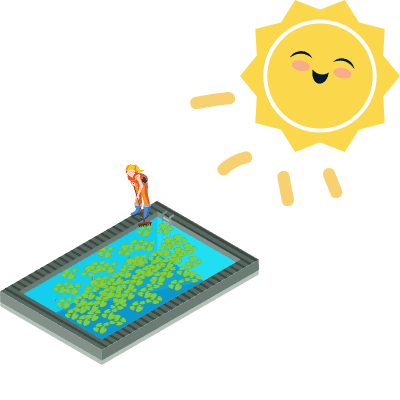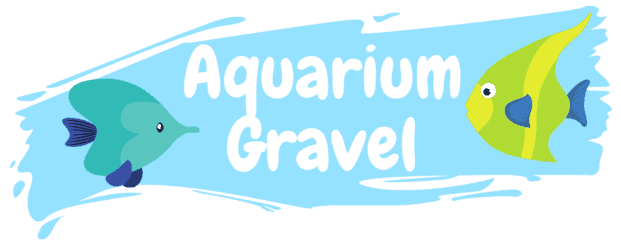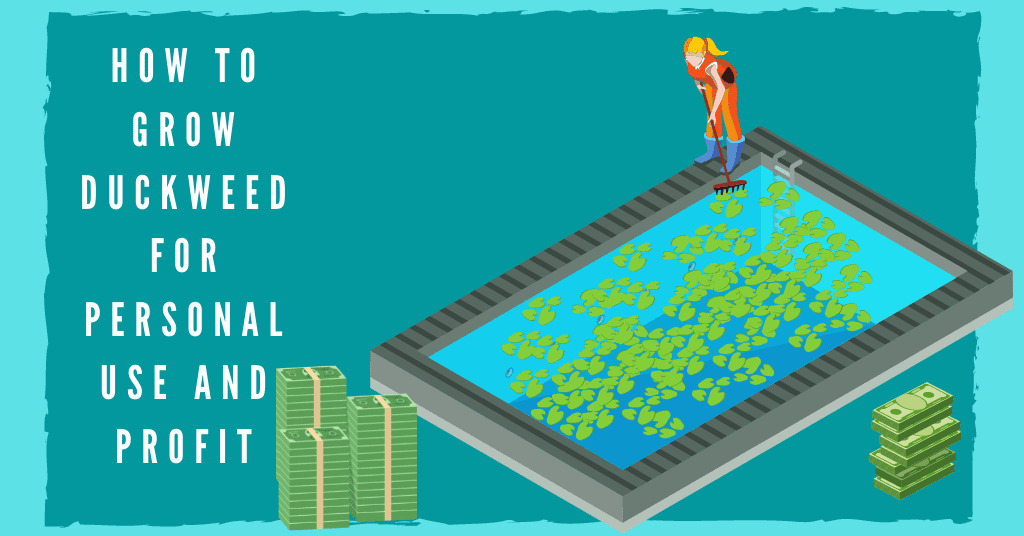Last Updated on October 24, 2021 by cmoarz
In some circles, Duckweed is considered an invasive plant. In others, it’s a valuable commodity, source of protein, water cleaning, and habitat. This article focuses on the latter And will teach you all about how to grow and care for duckweed for profit.
This aquatic species, Sometimes known as one of the smallest flowering plants in the world, Is packed with nutrients. It contains up to 40% plant protein which makes it an excellent source for fish, Animals, and human consumption. When powdered, It can almost entirely replace animal protein powders for vegetarians, vegans, and animal feed.
So needless to say it’s in high demand and has many ways to be sold. When something is in demand, It’s profitable!
It’s also really easy to grow. In fact, Growing duckweed is so easy, there’s almost no prep involved. It’s like growing soggy cash!
Other aquatic species tend to need more care and maintenance, But not duckweed. Direct Sunlight, Some light plant fertilizer, Some water, And you are good to go!
At least, That’s what I would like to say, but there are a few details you need to know to be successful growing duckweed, So keep reading before you rush off to pour some water in a bucket!
Let’s break down what you’re going to need to accomplish this task.

To grow this aquatic plant, You will need a few things
Table of Contents
Here you will find a list of things you will need to grow duckweed. Bellow ill explain each one in detail and what you will need to know about them.
Basic access too:
- Water
- Space (pond, container, etc)
- Direct Sunlight
- Fertilizer
- Seed Duckweed (Culture duckweed)
While each thing on this list seems like a “duh” there are some things you will need to know for optimal results.
Equipment list:
- pH meter
- Water Dechlorinator
- Plastic sheeting or containers
- Fish net
- Air pump and stone
- Possibly fish
- Magnifying glass
- Seive
- Dehydrator or oven (for powder, optional)

Water Parameters and Water Temperature
If you’re not growing in a local pond, then this section is super important. If you are growing in a pond, We touch on that in the next section.
Water quality is important when growing duckweed. Water should be chlorine and chloramine-free. Dechlorinated water, treated tap water will work just fine, as will pond water if you have access to it. To remove chlorine, you can just let it sit out for 24 hours while the chlorine evaporates.
Soft or hard water will work and duckweed has no real preference. The ideal pH is 6-7 but this hearty plant grows in as low as 5 and as high as 9.
The optimal water temperature between 14°C and 33°C (57.2°F to 91.4°F).
Lower or higher temperatures won’t kill the duckweed, but it won’t grow either. This is a common problem with new growers who say “Why isn’t my duckweed growing”, and almost always the cause is water temperature.

Grow space and what you intend on growing duckweed in
You have a lot of options when trying to choose where you want to grow your duckweed. There are a few things you should keep in mind when choosing, however.
Duckweed grows very fast, but only at the top of the water. All that space below is wasted space (with some exceptions we’ll talk about in the fertilizer section).
In reality, Duckweed only needs 3 inches of water to be quite happy, but the surface area remains the biggest factor in how much you can grow.
While duckweed carpeting can get quite thick with its rapid growth, there will be a limit to the surface space you will have access to.
The container you choose should be long and narrow (rectangular container) for easier access. If you can’t reach the middle, it might be a pain to harvest later on.
Some good options are plastic kids pools, Shallow Tupperware containers, etc. But what I’ve found that works best is a 5-inch deep wooden tray with a plastic liner. You can also use rows of cinderblocks as walls to lay plastic liners inside. I recommend Clear or white greenhouse plastic such as this.
If you intend on fertilizing by having fish, I recommend you do not go the shallow method, as fish will need slightly more space.
If you are using a pond, there isn’t really much you need to consider. Just toss some duckweed in and let it grow. Consider clearing any debris to maximize space. You will also need to find a way to harvest it when necessary.

Light, Sunlight or grow lights
Right off the bat, If you rely on grow lights or any type of full-spectrum light that uses electricity, you’re not going to turn a profit! At least, Your margins will be much lower.
The best light you can use is natural direct sunlight. On a small scale with a fish tank or tray, a sunny window cill will work, At a large scale, Being outside or in a greenhouse is going to be a must to grow bulk.
Duckweed will require at least 6 hours of sunlight a day. However, if you want to use a grow light for smaller amounts, “Light intensity and photoperiod had a significant effect on biomass and starch production. 110 μmol m−2 s−1 was the best light condition for duckweed biomass and starch accumulation.“.
More intense light will mean denser growth on the water surface. Duckweed will also outgrow algae in none transparent containers, While in transparent containers you may need to deal with algae growth from the light pollution coming through.

The best fertilizer you can use for duckweed
Duckweed requires nutrients that are pretty straightforward. Common duckweed only requires 4 things to really get it going. Nitrogen, Potassium (potash water-soluble), and micronutrients (and trace minerals). By giving these basic plant fertilizers to your duckweed, You can increase its growth and protein increase levels from 35% to 40%.
There are several ways you can achieve this mixture with relative ease and will work with the most common duckweed species.
There are store-bought fertilizers, like this one. Using these pre-mixes can save you a lot of hassle of figuring out the soluble levels for KNO3 and balancing everything else by hand. But if you are into that sort of thing, you can mix your own and save quite a bit of money, which means a bigger profit when you sell your duckweed.
This nutrient calculator can help in that case.
The all-natural way tends to be the best way in my opinion, and that’s to add fish. The downside is it makes the setup slightly more complicated. You will need to add an oxygen stone and basic filtration to each table to keep water quality up. The table itself will need to be deeper as well to accommodate the fish. Depending on the size, At least 10 inches.
The oxygen stone is especially important or the plant coverage will result in fish kill. The stone and pump you choose should provide enough oxygenation for the size of your duckweed container. Consider adding multiples from the same pump, But also remember duckweed likes still water.
You will also need to feed the fish on a regular schedule. It’s worth it in my opinion as it creates a much more organic fertilizer for your duckweed.
Koi fish are a bad idea unless you’ve got an entire pond or very large basin for them. Smaller fish and aquatic creatures such as rice fish are more ideal. Goldfish should be avoided as well unless they are a dwarf species, as they can get quite large.
Don’t be afraid to also add fertilizer to a pond or container with fish in it as well. The 2 are compatible, just follow the directions on the bottle.

Choosing your seed Duckweed species
The duckweed family is made up of 5 aquatic genera.
- Spirodela
- Landoltia
- Wolffiella
- Lemna
- Wolffia
Which combines have at least 38 species in the families. I’m going to save you some time by telling you the most common species people want are:
Spirodela and landolita and Lemna Minor (Common duckweed).
There are a lot of ways to get your initial starting culture of duckweed. The local pet store will usually carry a variety that’s generally mostly pest-free. You can also check online as well as go grab some from a local pond. You should disinfect any live plants you get from the wild first before adding it to your farm.
Only pick the most healthy specimens with light green leaves and short stems (shorter than 1 inch). Avoid obvious stem damage and overly dense colonies.

Geographical locations and growing seasons
Duckweed growth does best in warm climates that get a lot of direct sunlight in a sunny location, but it’s known to grow all over the world between USDA plant zones 4 through 10. It requires very little shade.
It will survive a cold winter and start growing again in spring, nothing special needs to be done unless you plan on farming it all winter long as well. In that case, it’s best to either grow it in a warm zone with warm winters, move your grow indoors, Or a greenhouse.

Pest Control of your duckweed crop
No matter your intentions or original source of duckweed, You’re eventually going to end up with pests. As an important step to harvest, You will find yourself in need to disinfect duckweed harvests often enough.
The most common pests you will face is pond snails and the China-mark moth larvae. These are actually really interesting as they cut out a piece of the leaf and turn it into a boat around their bodies. However, they will damage people’s aquariums and no one wants to accidentally eat one right?
To deal with moths and snails, dose your container with Thuricide (Bacillus Thuringiensis) which is harmless to fish but will take out the larvae and snails.
To disinfect the duckweed itself at harvest, Prepare a bath of 1 teaspoon bleach or potassium permanganate to 11 gallons of water and allow to soak for a few minutes. Then rinse well.
You should use this bleach or potassium permanganate method when you first get your culture as well to avoid unwanted hitchhikers and eggs.

Other Tips, Tricks, and important notes
Duckweed will cause oxygen depletion in ponds if the mat gets too thick and covers the majority of the pond. While duckweed itself doesn’t use oxygen, it will prevent sunlight from reaching algae that do produce it. This can cause a fish kill.
Other plants will be out-competed by duckweed explosive growth rates. Couple with oxygen depletion, ponds are a bad way to farm duckweed en mass, as the pond water will slowly become deoxygenated and dead with only duckweed at its surface, and other aquatic plant to be forced out.
All duckweed and related floating plant, (duckweed lemna, minor, wolffia, spirodela etc) grows and divides asexually and requires no special pollination on your part.
Prevent splashing as much as possible in the basin you intend on growing your duckweed, as it prefers quiet still water. Put your airstone in a pipe if necessary to stop the water from breaking with bubbles and causing excess water movement.
Remember to top off your containers to compete with water evaporation.
You can use a small pump in the middle or bottom water column to prevent the water from stagnating too much – Just don’t let it agitate the surface.
Go to youtube and learn even more about how to grow duckweed!
Preparing your duckweed for sale
Remove excess duckweed from the surface with a skimmer or large fish net. Depending on how you’re going to sell it will change how you process it going forward.
Disinfect and remove pests the best you can.
If you want to powder your duckweed to sell it as protein powder (for human consumption), it must be sterilized extremely well.
Dry the duckweed at 60 – 80 C for 18-20 hours and then powder it. Put it through a 100-200 mesh sieve.
There may be more regulations you need to follow in your area if you are selling duckweed protein powder for human consumption. However, it is a significant potential food source and does sell well which can make it a worthwhile investment. Especially given how fast duckweed grows.
Selling your duckweed, Finding vendors and communities
I usually sell duckweed by the handfuls at about 10$ per handful. As you can imagine, it’s like growing soggy money!
Finding vendors and people interested in purchasing it is pretty straightforward, and these are the routes i take to get that done:
- Talk to the local pet store and see if they are interested in a constant supply or will carry your own labeled product on their shelves for a cut.
- Make use of facebook marketplace to list your product to the local market. A lot of people go here first when looking to buy.
- Craigslist, Kijiji, or other local-based classifieds are a great source of constant customers.
- Duckweed is one of the few aquatic plants that ships pretty well without a large number of casualties. Consider opening your own online store, or selling it on etsy.
About
Owner of AquariumGravel.com and also owner of actual Aquarium Gravel believe it or not! ;). Setting up beautiful aquarium sceneries and habitats since I was very young. Enjoy!
- Web |
- More Posts(290)

